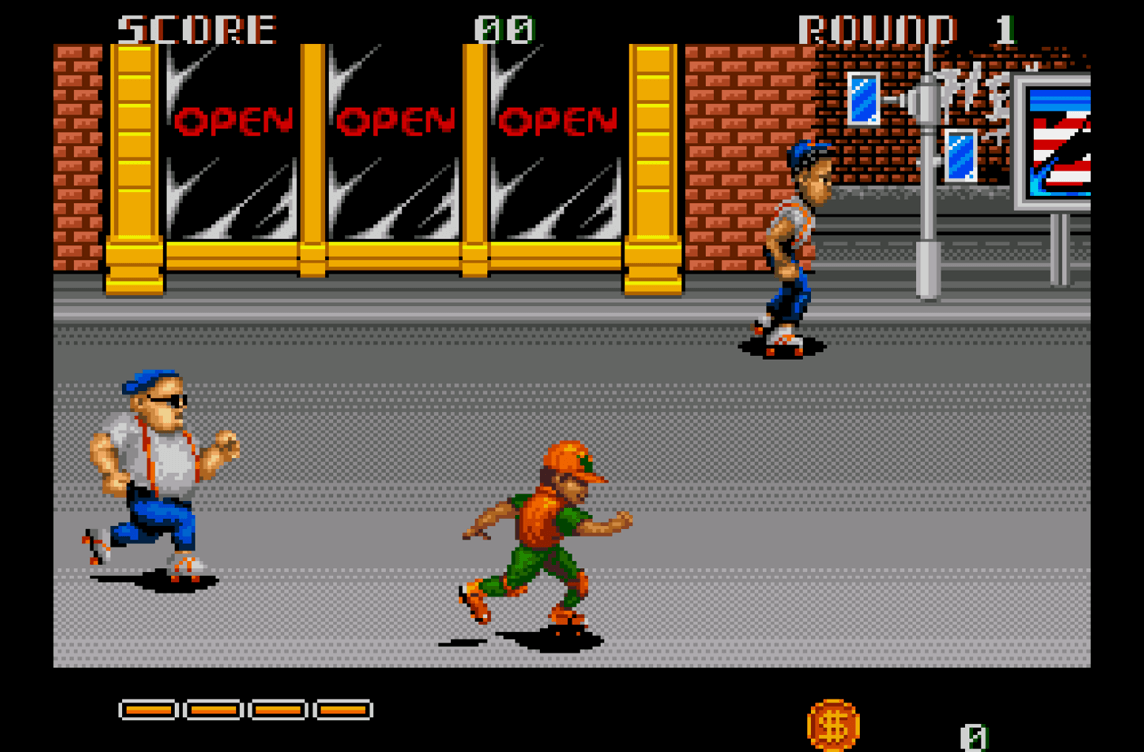Amidst the tidal wave of beat-’em-ups attempting to replicate Double Dragon‘s success, DJ Boy emerged, donning roller skates and offering a standard yet intriguing entry in the genre. As we delve into this Genesis classic, we’ll explore its gameplay, alterations from the arcade original, and the peculiarities that set it apart.
A Genesis in Diversity
The early ’90s was an era defined by a slew of side-scrolling brawlers, each striving to leave its mark on the gaming landscape. DJ Boy, developed by Kaneko, ventured into this fray with a distinctive roller-skating twist. Released for the Genesis in 1990, it brought a novel aesthetic to the beat-’em-up genre.
The premise centers around the eponymous DJ Boy, embarking on a quest to retrieve his stolen boom box. This narrative departure from the customary “save the girlfriend” trope injected a touch of originality into the game’s foundation. However, this intriguing premise was somewhat diluted in the American version, where DJ Boy assumes the role of a girlfriend rescuer, conforming to a more conventional storyline.
The Curious Case of Alterations
The Genesis port of DJ Boy introduced several noteworthy changes from its arcade progenitor. Some of these modifications, such as character redesigns and alterations to boss animations, may seem peculiar in retrospect. Notably, “Big Mama,” the initial boss, underwent some eyebrow-raising alterations, transforming her flatulence animation into a potent attack.

The cooperative mode, a staple in beat-’em-ups, was conspicuously absent from the Genesis version, raising questions about the rationale behind this omission. It’s possible that technical constraints or budgetary considerations played a role in this decision, underscoring the compromises that developers often faced during this era.
The Beat-’em-Up Ballet
As DJ Boy hurtles through the game on roller skates, players are armed with a simple arsenal of punches and kicks. This streamlined combat system eschews complex combos or special moves, adopting a button-mashing ethos. While this approach may lack the depth of more nuanced fighting mechanics, it aligns with the straightforward nature of early ’90s beat-’em-ups.
Enemies, cast as run-of-the-mill thugs, exhibit a level of obliviousness that renders them more akin to hapless caricatures than formidable adversaries. Dispatching these foes becomes a routine exercise in swift, rhythmic violence. While punches possess limited range, they’re rarely essential, a testament to the simplicity that characterizes DJ Boy’s combat dynamics.
Boss Battles and Tactical Finesse
Boss encounters represent a departure from the mindless brawls with henchmen. These formidable adversaries boast substantial life bars, demanding a more calculated approach. For instance, Big Mama, the initial boss, proves impervious to head-on assaults, necessitating a more strategic offensive.
Attempting to overpower these bosses through sheer force will invariably lead to defeat, underscoring the importance of discerning attack patterns. Each boss inflicts considerable damage, emphasizing the need for precise timing and tactical finesse to emerge victorious.
Empowering Progression
Upon completing a level, players are ushered into a store, where coins collected from vanquished foes can be invested in various upgrades. These enhancements encompass speed, power, endurance, and vital health replenishment. A judicious allocation of resources can pave the way for an increasingly dominant DJ Boy, capable of dispatching basic enemies with a single, devastating blow by the fourth level.
A particularly noteworthy power-up takes the form of a cute kitty icon, representing an extra life. In a game characterized by its unforgiving nature, these additional lives prove indispensable for navigating DJ Boy’s formidable challenges.

Visuals and Acoustics: A Snapshot of the Era
Visually, DJ Boy adheres to the aesthetic standards of early Genesis titles. While not particularly striking, the game’s graphics serve their purpose, with minimal parallax scrolling and a restrained color palette. Animations are sparingly used, reflecting the technical constraints of the era.
The audio design mirrors the visual elements, encapsulating the sonic sensibilities of early ’90s gaming. While the presentation may not be groundbreaking, it successfully evokes a sense of nostalgia for those familiar with the era’s auditory landscape.
A Palette of Level Design
Amidst the sea of mediocrity, DJ Boy boasts moments of level design brilliance. The dark, obstacle-laden subway run in level two introduces an element of challenge and intrigue. Similarly, level four’s high-rise construction site teeters on the precipice of peril, demanding precise execution to navigate the treacherous terrain.
While some enemy encounters evoke missed opportunities for deeper engagement, the diverse settings inject a sense of variety into DJ Boy’s gameplay. Dynamite-tossing adversaries and other unique encounters punctuate the journey, leaving players with memorable vignettes within the larger beat-’em-up canvas.
The Verdict: DJ Boy’s Retro Resonance
Ultimately, DJ Boy occupies a distinctive niche within the annals of early ’90s beat-’em-ups. Its roller-skating motif and idiosyncratic boss characters endow it with a peculiar charm
Play DJ Boy Online Anywhere, Anytime!
Now you can enjoy DJ Boy online, fully playable in a web browser!